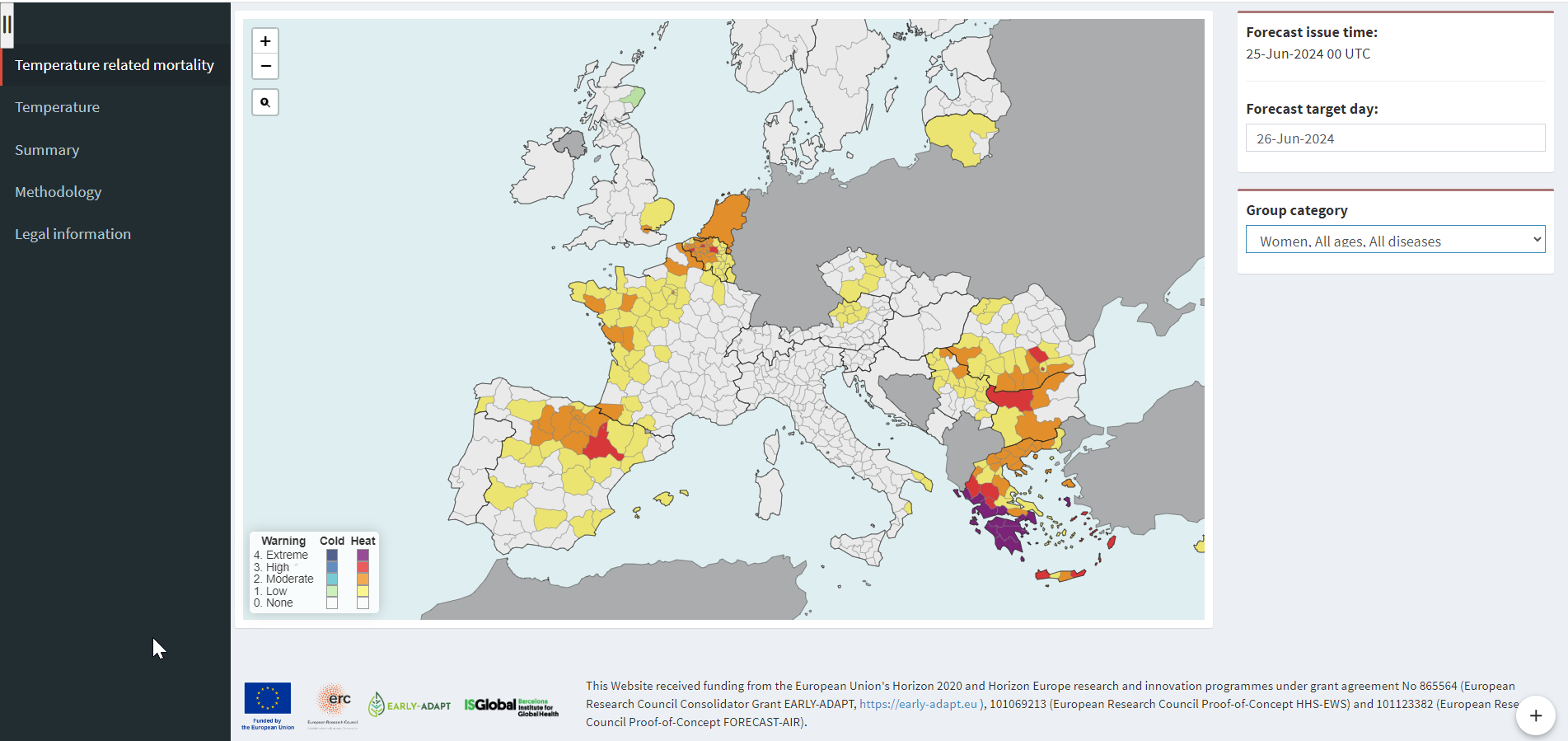New epidemiological tool provides warnings of heat and cold related mortality by sex and age in Europe
Forecaster.health, an open-access health early warning system for 580 regions in 31 European countries, has been funded by the European Research Council
26.06.2024
Ambient temperatures are associated with over 5 million premature deaths worldwide every year, more than 300,000 of which in Western Europe alone. In a context of rapidly warming temperatures that successively broke previous records during the last two decades , it is essential to use epidemiological models to develop novel, impact-based early warning systems predicting the health effects of forecast temperatures.
This is precisely what the Adaptation group at the Barcelona Institute for Global Health (ISGlobal), a centre supported by the "la Caixa" Foundation, has done: Forecaster.health is the first pan-European, open-access platform using sex- and age-specific epidemiological models to predict the actual mortality risks of ambient temperatures for different segments of the population.
The tool allows users to enter the date for which they want to obtain the health predictions within a window of up to two weeks, as well as the population subgroup for which they want to obtain the prediction of temperature related mortality . Once these variables have been selected, the system displays a map showing warnings for 580 regions in 31 European countries with colour codes corresponding to four levels of heat and cold related mortality risk: low, moderate, high and extreme.
Change in paradigm: from meteorology to epidemiology
"Until now, temperature warnings have been solely based on the physical information of weather forecasts, and therefore, they ignore the differences in vulnerability to heat and cold among population groups. Our system changes this paradigm by shifting the focus from meteorology to epidemiology and the social determinants of vulnerability to the environmental factors", says Joan Ballester Claramunt, principal investigator of the Adaptation group at ISGlobal. " Forecaster.health does not only forecast the temperatures themselves, but also the actual risks that these temperatures have on the population as a whole, and especially, on specific population subgroups based on sex and age", he adds.
The team used the mortality database of the project EARLY-ADAPT (https://www.early-adapt.eu), which currently includes data for 580 regions in 31 European countries by sex, age and cause of death, to fit separate epidemiological models for population groups. Every day, the tool obtains temperature records and forecasts, and uses the epidemiological models to quantify the risk of temperature related mortality by sex and age group for any given date within the following 15 days.
“We know that vulnerability to heat is influenced by a number of factors, including sex and age. We know, for example, that women are more susceptible to heat than men, and that the risk of death for both heat and cold increases with age. For that reason, our tool separately fits epidemiological models for each sex and age group, which allows us to issue independent warnings accounting for the real impacts on the population”, says Marcos Quijal-Zamorano, researcher at ISGlobal and one of the authors of the system.
The first step towards a multi-hazard platform
Always based on epidemiological evidence and models, Forecaster.health will be expanded in the next months and years in different directions. To begin with, new countries and smaller regions will be added to the platform, as soon as new data is acquired by the team. The tool is also expected to develop new epidemiological models to incorporate health warnings for several air pollutants, such as particulate matter, ozone or nitrogen dioxide. Finally, the platform will also issue warnings for specific causes of death, such as cardiovascular and respiratory diseases, and for other health outcomes, such as hospital admissions and occupational accidents.
“Our approach crucially depends on the availability of health data to fit our epidemiological models. We are eager to add additional health outcomes for more countries or smaller regions, either from Europe or in other continents, if data is provided to us”, emphasises Joan Ballester Claramunt .
Proof-of-Concept Grants of the European Research Council
Forecaster.health has been funded by the Proof-of-Concept Grants HHS-EWS and FORECAST-AIR of the European Research Council (ERC). These grants are aimed at transforming the basic research and resources generated in the ERC Consolidator Grant EARLY-ADAPT into innovative tools to address societal challenges. In that regard, EARLY-ADAPT is studying how populations are adapting to the public health challenge of climate change, and consequently, HHS-EWS and FORECAST-AIR are offering real solutions to increase the resilience of societies to environmental threats such as ambient temperatures and air pollutants.
The team that developed the platform is composed by Joan Ballester Claramunt, Mireia Beas-Moix, Nadia Beltrán-Barrón, Raúl Fernando Méndez Turrubiates, Fabien Peyrusse andMarcos Quijal-Zamorano.



